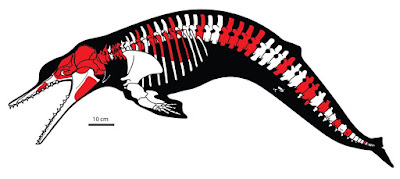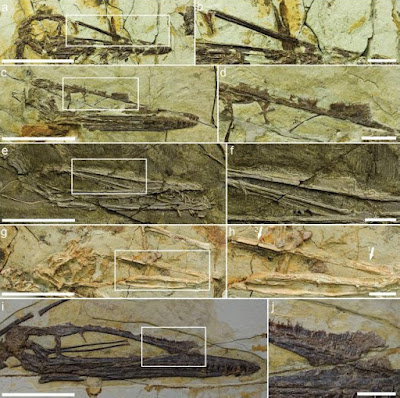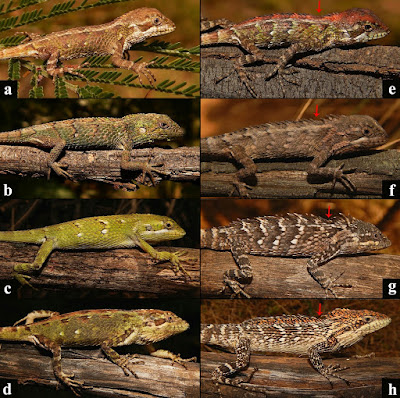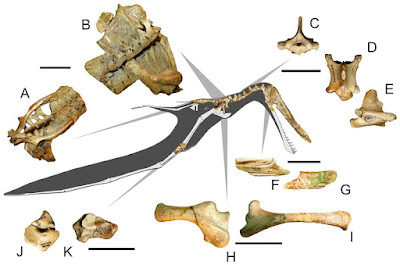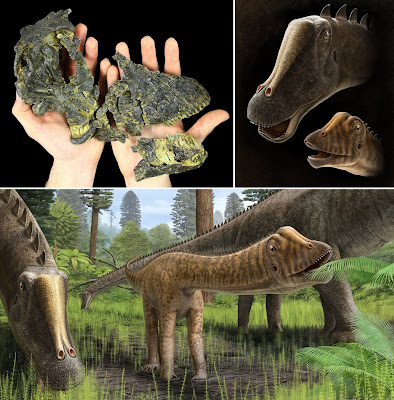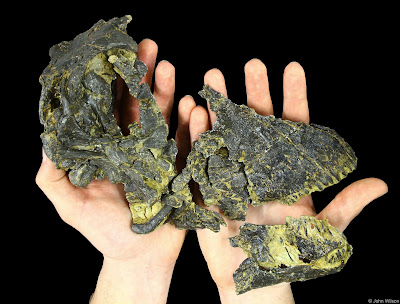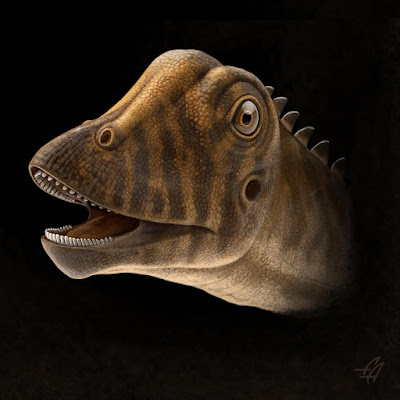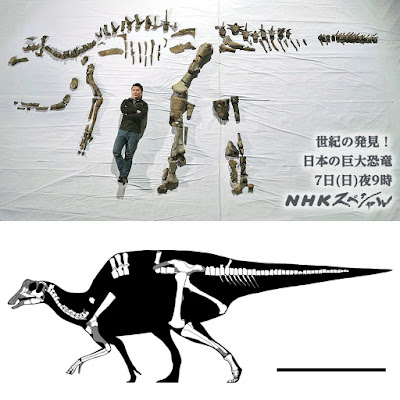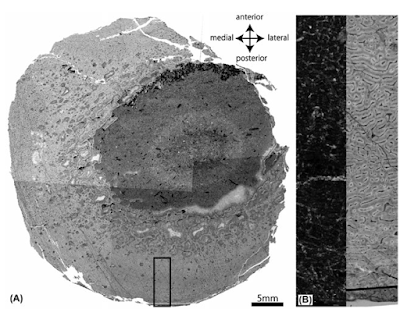 |
| Albertocetus meffordorum Uhen, 2008 Boessenecker, Ahmed & Geisler, 2017 |
Abstract
We report five new specimens of xenorophid dolphins from North and South Carolina. Four of the specimens represent the xenorophid Albertocetus meffordorum, previously only known from the holotype skull. The other is a fragmentary petrosal from the upper Oligocene Belgrade Formation that we refer to Echovenator sp, indicating at least two xenorophids from that unit. Two of the Albertocetus meffordorum specimens are from the lower Oligocene Ashley Formation: 1) a partial skeleton with neurocranium, fragmentary mandible, ribs, vertebrae, and chevrons, and 2) an isolated braincase. The partial vertebral column indicates that Albertocetus retained the ancestral morphology and locomotory capabilities of basilosaurid archaeocetes, toothed mysticetes, and physeteroids, and caudal vertebrae that are as wide as tall suggest that the caudal peduncle, which occurs in all extant Cetacea, was either wide or lacking. CT data from the isolated braincase were used to generate a digital endocast of the cranial cavity. The estimated EQ of this specimen is relatively high for an Oligocene odontocete, and other aspects of the brain, such as its anteroposterior length and relative size of the temporal lobe, are intermediate in morphology between those of extant cetaceans and terrestrial artiodactyls. Ethmoturbinals are also preserved, and are similar in morphology and number to those described for the Miocene odontocete Squalodon. These fossils extend the temporal range of Albertocetus meffordorum into the early Oligocene, its geographic range into South Carolina, and expand our paleobiological understanding of the Xenorophidae.
Systematic paleontology
Cetacea Brisson, 1762
Pelagiceti Uhen, 2008
Odontoceti Flower, 1867
Xenorophidae Uhen, 2008
Albertocetus Uhen, 2008
Albertocetus meffordorum Uhen, 2008
.....
Conclusions
1. New odontocete specimens from the lower Oligocene Ashley Formation of South Carolina include an isolated cranium and a partial skeleton including incomplete cranium with petrotympanics and fragmentary mandible, cervical, thoracic, lumbar, and caudal vertebrae, ribs, and a chevron. These specimens extend the range of Albertocetus meffordorum into the early Oligocene.
2. Well-preserved petrosals permit more refined identification of a recently reported petrosal from the upper Oligocene Belgrade Formation of North Carolina as Echovenator sp., and permit referral of two additional Belgrade Formation petrosals to Albertocetus meffordorum and Echovenator sp. Future collecting efforts in North Carolina are expected to yield other cetaceans conspecific with those from the contemporaneous Chandler Bridge Formation of South Carolina.
3. The endocast of Albertocetus meffordorum is intermediate in morphology between extant odontocetes and archaeocete whales. Endocast volume indicates that Albertocetus meffordorum is the most highly encephalized odontocete from the early Oligocene (EQ = 2.586), well within the range of extant delphinoids, and chronicling a drastic jump in EQ across the Eocene-Oligocene boundary. Further study of appropriate body size estimation is needed to investigate the proposed Eocene-Oligocene explosion in odontocete encephalization.
4. The sample size of Albertocetus meffordorum permits the first basic examination of ontogenetic trends in stem Odontoceti. Ontogenetic study of Albertocetus meffordorum identifies several sutures of the dorsal braincase and facial region of interest for assessing ontogenetic status in stem Odontoceti (e.g. median parietal suture, frontoparietal suture, frontonasal suture, parieto-occipital suture), to be confirmed with larger samples of undescribed xenorophids (e.g. Echovenator, Xenorophus). Postcranial epiphyseal fusion is achieved earlier in ontogeny than cranial suture closure in A. meffordorum.
5. Vertebral proportions indicate that Albertocetus meffordorum, like basilosaurids, Mysticeti, and sperm whales, is a "pattern 1" species with no anteroposterior specialization of the vertebral column. This indicates that dorsoventral undulation occurred through the entire flexible lumbocaudal series; this appears to characterize stem odontocetes. Rectangular caudal vertebrae indicate the presence of caudal flukes. Surprisingly, no caudal vertebrae are transversely narrower than tall, suggesting the absence of a transversely narrowed peduncle as in all extant Mysticeti and Odontoceti. Such a feature would imply that the narrow peduncle evolved independently. However, skeletons of stem odontocetes and mysticetes with a more complete caudal series are required to further evaluate this hypothesis.
Robert W. Boessenecker, Erum Ahmed and Jonathan H. Geisler. 2017. New Records of the Dolphin Albertocetus meffordorum (Odontoceti: Xenorophidae) from the lower Oligocene of South Carolina: Encephalization, Sensory Anatomy, Postcranial Morphology, and Ontogeny of early Odontocetes. PLoS ONE. 12(11); e0186476. DOI: 10.1371/journal.pone.0186476
New postcranial skeleton of ancient dolphin Albertocetus meffordum found in South Carolina phy.so/429369468 via @physorg_com
twitter.com/tetrameryx/status/929095659667492870
Fossils in @CofCNatHistory collections @CofC
Fossils in @CofCNatHistory collections @CofC
---------------------------------------------------------------
روابط التحميل والمشاهدة، الروابط المباشرة للتحميل
او
شاهد هذا الفيديو القصير لطريقة التحميل البسيطة
كيف تحصل على مدونة جاهزة بآلاف المواضيع والمشاركات من هنا
شاهد قناة منتدى مدونات بلوجر جاهزة بألاف المواضيع والمشاركات على اليوتيوب لمزيد من الشرح من هنا
رابط مدونة منتدى مدونات بلوجر جاهزة بآلاف المواضيع والمشاركات في أي وقت حــــتى لو تم حذفها من هنا
شاهد صفحة منتدى مدونات بلوجر جاهزة بألاف المواضيع والمشاركات على الفيس بوك لمزيد من الشرح من هنا
شاهد صفحة منتدى مدونات بلوجر جاهزة بألاف المواضيع والمشاركات على الفيس بوك لمزيد من الشرح من هنا
تعرف على ترتيب مواضيع منتدى مدونات بلوجر جاهزة بآلاف المواضيع والمشاركات (حتى لا تختلط عليك الامور) من هنا
ملاحظة هامة: كل عمليات تنزيل، رفع، وتعديل المواضيع الجاهزة تتم بطريقة آلية، ونعتذر عن اي موضوع مخالف او مخل بالحياء مرفوع بالمدونات الجاهزة بآلاف المواضيع والمشاركات، ولكم ان تقوموا بحذف هذه المواضيع والمشاركات والطريقة بسيطة وسهلة. ــــــــــــــــــــــــــــــــــــــــــــــــــــــــــــــــــــــــــــــسلامـ.



